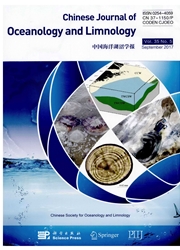

 中文摘要:
中文摘要:
人为的二氧化碳的海洋的举起在海水 pH 导致减少,作为海洋使发酸知道的一个过程。珍珠牡蛎 Pinctada fucata,高贵扇贝斗篷的一种 nobilis,和绿嘴唇的贻贝 Perna viridis 是沿着中国的南部的海岸的经济、生态的重要性的种类。我们在这在清理,呼吸,和排泄率上评估了海水使发酸的效果三种。ammals 在 pH 在海水被饲养 8.1 (控制) , 7.7,或 7.4。清理率在 pH 是最高的 7.7 为 P。fucata 并且在 pH 8.1 为 C。nobilis 和 P。viridis。pH 在 P 的呼吸率上有小效果。fucata 和 P。viridis。相反,呼吸率在 pH 是显著地更低的 7.4 在 C。nobilis。排泄率在 pH 是显著地更低的 7.4 比 pH 8.1 为所有种类。结果显示在海水 pH 的减小多半影响了这些瓣鳃类的新陈代谢的过程(食物吸入,氧消费,和氨排泄) 。不同种类对海水使发酸不同地作出回应。进一步的研究被需要为这效果表明准确 mechamsms 并且评估这些瓣鳃类的适应性到未来酸化的海洋。
 英文摘要:
英文摘要:
Oceanic uptake of anthropogenic carbon dioxide results in a decrease in seawater pH, a process known as "ocean acidification". The pearl oyster Pinctada fucata, the noble scallop Chlamys nobilis, and the green-lipped mussel Perna viridis are species of economic and ecological importance along the southern coast of China. We evaluated the effects of seawater acidification on clearance, respiration, and excretion rates in these three species. The animals were reared in seawater at pH 8.1 (control), 7.7, or 7.4. The clearance rate was highest at pH 7.7 forP.fucata and at pH 8.1 for C. nobilis and P. viridis. The pH had little effect on the respiration rate of P.fucata and P. viridis. In contrast, the respiration rate was significantly lower at pH 7.4 in C. nobilis. The excretion rate was significantly lower at pH 7.4 than pH 8.1 for all species. The results indicate that the reduction in seawater pH likely affected the metabolic process (food intake, oxygen consumption, and ammonia excretion) of these bivalves. Different species respond differently to seawater acidification. Further studies are needed to demonstrate the exact mechanisms for this effect and evaluate adaptability of these bivalves to future acidified oceans.
 同期刊论文项目
同期刊论文项目
 同项目期刊论文
同项目期刊论文
 期刊信息
期刊信息
